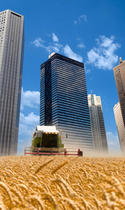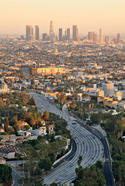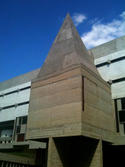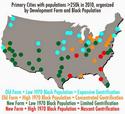Recent events in Ferguson, Missouri and along the U.S.-Mexico border may seem to suggest that race has returned as the signature issue in American politics. We can see this already in the pages of mainstream media, with increased calls for reparations for African-Americans, and expanded amnesties for the undocumented. read more »
Urban Issues
On The Pitfalls of Urban Food Production
In her August 21 pieces “Can Urban Agriculture Work on a Commercial Scale?” and “Five Urban Farms that are Growing Big” published in Citiscope, journalist Flavie Halais enthuses over the potential for small scale urban agriculture, vertical farming, and innovative ways to connect producers and consumers. In doing so, she ignores some very real pitfalls that have long relegated urban food production to the realm of hobbyists.
Pitfall #1: Urban land is too valuable to be devoted profitably to food production
Until a century ago many foods that did not travel well, or benefitted from organic waste (primarily horse manure) generated in cities, were still produced in and around large urban agglomerations. read more »
Traffic Congestion in the World: 10 Worst and Best Cities
The continuing improvement in international traffic congestion data makes comparisons between different cities globally far easier. Annual reports (2013) by Tom Tom have been expanded to include China, adding the world’s second largest economy to previously produced array of reports on the Americas, Europe, South Africa and Australia/New Zealand. A total of 160 cities are now rated in these Tom Tom Traffic Index Reports. read more »
- Login to post comments
America's Fastest-Growing Small Cities
Coverage of America’s changing urban scene tends to focus heavily on large metropolitan areas and the “megaregions” now often said to dominate the economic future. Often missed has been a slow, but inexorable, shift of migration and economic growth to smaller cities, a geography usually ignored or dismissed, with the exception of college towns, as doomed to lag behind by urban boosters. read more »
- Login to post comments
L.A. Hanging on as a Top Global City
For more than a century, Southern Californians have dreamed of their region becoming host to a great global city. At the turn of the 20th century Henry Huntington, who built much of the area’s first mass-transit system, proclaimed that “Los Angeles is destined to become the most important city in the world.”
Of course, builders of other cities – St. Louis, New Orleans, Chicago and even Cincinnati, Ohio – have made similar predictions. But L.A.’s claim, unlike the others, had a significant resonance. Not only was the region growing rapidly throughout the previous century, and now stands as North America’s second-largest population center, but it dominated a host of fields, notably entertainment and aerospace, and was highly influential in energy, fashion and manufacturing. read more »
Why Modern Architecture Struggles to Inspire Catholics
Inspired by a recent visit to a Le Corbusier-designed Dominican monastery near the French city of Lyon, I’ve been thinking a lot about the interaction between Catholicism and modernist aesthetics. It has little to do with whether the Church affects what designers create beyond filling the program. Instead, I’ve tried to examine how the architect’s religion influences the Church’s own self-image. I’ve concluded that the Church, an institution that has been the guardian tradition and the patron artistic and architectural development in the West for almost two millennia, never could reconcile itself comfortably with Modernism. read more »
Urbanist Goals Will Mean Fewer Children, more Seniors Needing Government Help
America’s cognitive elites and many media pundits believe high-density development will dominate the country’s future.
That could be so, but, if it is the case, also expect far fewer Americans — and far more rapid aging of the population.
This is a pattern seen throughout the world. In every major metropolitan area in the high-income world for which we found data — Tokyo, Seoul, London, Paris, Toronto, New York, Los Angeles, and the San Francisco Bay area — inner-core total fertility rates are much lower than those in outer areas. read more »
Ranking America's Top Young Labor Forces: A Rust Belt Rising?
This is a new report brief from the Center for Population Dynamics at Cleveland State University, download the pdf version here. The report was authored by Richey Piiparinen, Charlie Post, and Jim Russell
Greater Cleveland ranks 8th nationally in the percentage of 25- to 34-year-olds in the labor force with a graduate or professional degree, ahead of such “brain hubs” as Chicago, Seattle, and Austin. The analysis speculates as to whether or not this is a leading indicator to broader economic growth. Comparisons are made with Boston and Pittsburgh—two metros further along in the economic restructuring process. read more »
- Login to post comments
Welcome to the Billion-Man Slum
When our urban pundit class speaks of the future of cities, we are offered glittering images of London, New York, Singapore, or Shanghai. In reality, the future for most of the world’s megacities—places with more than 10 million people—may look more like Dhaka, Mumbai, or Kinshasa: dirty, poverty- and disease-ridden, and environmentally disastrous. read more »
A Typology of Gentrification
Patterns of gentrification vary by city, and the spread of gentrified areas is partly determined by the city’s predominant development form and the historic levels of African-American populations within them. Gentrification is a nuanced phenomenon along these characteristics, but most people engaged in any gentrification fail to acknowledge the nuances. read more »





















